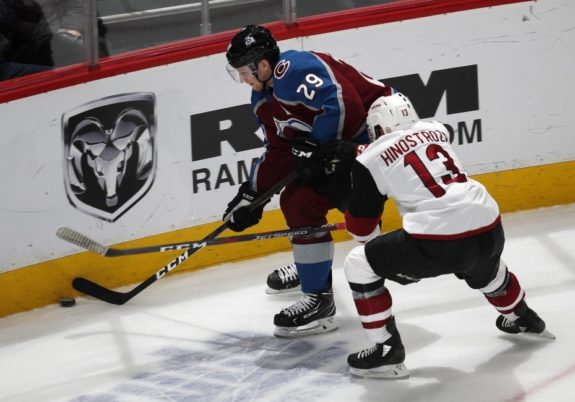The Colorado Avalanche are set to challenge for the Stanley Cup this season. In a realigned West Division, the Avalanche will face tough opponents in the Vegas Golden Knights and St. Louis Blues. The rest of the division won’t be as much of a challenge, but the Avs still won’t be an easy ride. Among the rest of the group, which includes the Anaheim Ducks, Arizona Coyotes, Los Angeles Kings, Minnesota Wild, and the San Jose Sharks, the biggest sleeper threat this season just might be their 2019-20 first-round playoff foes: the Coyotes.
The Avalanche should make the playoffs and be in a battle for the top spot in the West Division. The Coyotes will likely struggle for points throughout the season and, in the best-case scenario, battle their way into the fourth playoff spot in the division. But, throughout a 2020-21 schedule that has the Avalanche circling certain meetings with the Golden Knights and Blues, the stage is set for the Coyotes to be the unexpected challenge for the Avs this season.
First Round Hangover
Prior to their season-opening loss on Thursday, the last two meaningful games the Coyotes played were against the Avalanche in the first round of the 2019-20 playoffs. The Avalanche were shaking off a Game 3 loss to Arizona and made sure to imprint their logo on the Coyotes’ collective memory by eliminating them with back-to-back 7-1 wins. Rosters turnover in the offseason, but it’s not unreasonable to believe that this Coyotes group will be looking to get some revenge or prove their worth against a Cup-contending team and make these games difficult for the Avalanche.

To make matters more interesting and potentially slippery for Colorado, six of the eight games against the Coyotes precede or follow games against Vegas. The first four games against the Coyotes are split around a stretch of four consecutive games against Vegas (including the outdoor game at Lake Tahoe). This adds some weight to the psychological challenge for the Avalanche.
With key Vegas matchups and the excitement of the outdoor game to focus on from Feb. 14-22, the Avalanche won’t want to get caught looking ahead during their first two games against the Coyotes. For the two games that follow the Vegas run, the Avalanche will need to regroup for a new opponent and avoid hitting the relax button too early when they see the Coyotes on the schedule.
Defensive Strength Tested
The power of the Avalanche’s top-six forwards is a known treasure around the league. With the addition of Andre Burakovsky, Nazem Kadri, and Brandon Saad over the past two seasons, their top six can rival any first and second lines.
This doesn’t mean that their defensive depth is weak. But with the addition of Devon Toews and the absence (however brief) of a veteran presence in Erik Johnson, the defensive core will need some time to get to know one another. Some new combinations will be in play and will need to be worked out over the first few games, as was clear in the 2020-21 opener against St. Louis.
Despite losing Taylor Hall in the offseason, the Coyotes are a team with unique offensive weapons in straight shooter Phil Kessel (who will hope to rebound), Nick Schmaltz (who missed the playoff series against the Avs) and, on the backend, veteran Oliver Ekman-Larsson. The Coyotes may not win games by five goals, but their offensive potential shouldn’t be shrugged off because they lack a clear or consistent superstar offensive threat. They can still expose a defensive group that isn’t quite familiar with each other.

The Coyotes also added more grit up front in Tyler Pitlick and Derick Brassard. These acquisitions signal a desire to want to follow a Blues-style of play by balancing a heavier presence and skill. Regardless of where the inspiration comes from, the Coyotes will be harder to control from the defensive side for Colorado. The Avalanche have worked to balance their defensive core, but some of their key players are still quite young and relatively inexperienced. Cale Makar, Samuel Girard, and Conor Timmins all 22 years old.
With Bowen Byram looking to get into some action, the group will only get younger. This young and sometimes smaller group (Makar and Girard are under six feet tall) will be hit hard by a Coyotes team looking to grind pucks loose and feed their shooters. This grind and snipe combination is meant to wear down a defensive core and could present a challenge, but the speed and puck-moving skill of the Avalanche defense is designed to combat and neutralize this hard forecheck.
Darcy Kuemper
As much as Avalanche fans might like to think that Colorado solved Darcy Kuemper in the final two games against the Coyotes in the 2019-20 playoffs, Kuemper can shut down an offense without warning. What adds to this potential threat is that backup goaltender Antti Raanta seemed to return to form last season as well.

The Avalanche offense went quiet against the Blues in the 2020-21 season opener (including going 1-for-4 on the power play), forcing head coach Jared Bednar to shuffle the lines and look for a spark. There’s no need to overreact based on a loss in the first game, but a midseason meeting with a strong Kuemper and Raanta combination could frustrate an offense, even one as loaded as Colorado’s. However, the Coyotes rely on the strength of their goaltender more than most teams, and a tiring schedule might offer some relief by the time the Avalanche meet up with Arizona.
Manageable Threat
The Avalanche are the better team heading into this season and should finish well above the Coyotes in the standings, but circumstances around 2020-21 have created the potential for tight battles when these teams meet. There isn’t a reason for panic, nor is this an attempt to incite fear. It’s a note for the Avalanche and fans to walk lightly in the desert and don’t shrug off the Coyotes in Denver. It’s a reminder that every game will have something special to offer this season and be worth the watch.